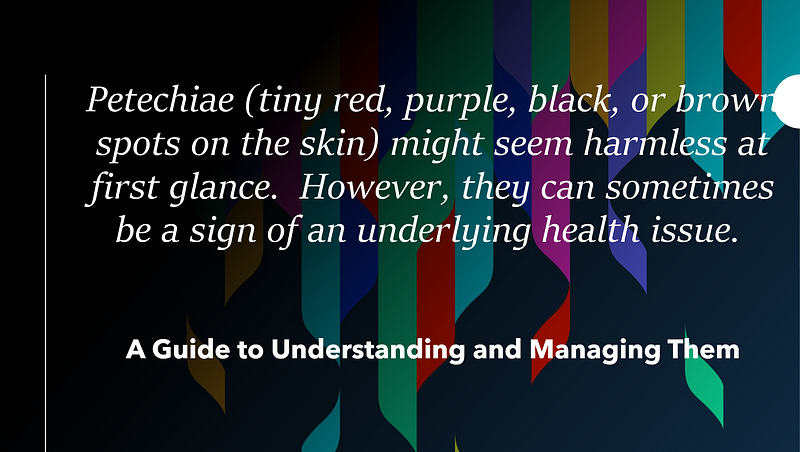Understanding Petechiae: A Comprehensive Guide to Management
Written on
Chapter 1: Introduction to Petechiae
Petechiae are those tiny red, purple, or brown spots that can appear on your skin, often overlooked as harmless. However, they may indicate underlying health issues. It is essential to comprehend what petechiae are, their causes, and how to manage them effectively for your overall health.

This article serves as a concise guide created at the request of subscribers seeking straightforward information about this health condition, devoid of complex case studies or scientific jargon. For more in-depth information, refer to my earlier articles.
Petechiae occur when small blood vessels break and bleed into the skin, forming flat spots that do not disappear when pressed. Although typically painless, they can signify more serious medical issues.
Section 1.1: Significance of Petechiae
These spots can serve as early warning signs of potential health concerns. They may indicate infections, blood clotting disorders, certain medications, or even serious conditions like meningitis or leukemia.
Some readers have expressed curiosity about the prevalence of petechiae. While exact global statistics are not available since petechiae is a symptom rather than a standalone condition, it is understood that they are relatively common, documented extensively in medical literature. The frequency of their occurrence can vary significantly based on underlying health issues or medications.
Section 1.2: Practical Steps for Managing Petechiae
- Maintain a Healthy Lifestyle
- A nutrient-rich diet supports vascular health.
- Regular exercise enhances circulation and fortifies blood vessels.
- Adequate sleep promotes healing.
- Stress-reduction techniques like yoga or meditation can mitigate inflammation.
- Keeping a healthy weight alleviates pressure on blood vessels.
- Avoid smoking and limit alcohol consumption for better vascular health.
- Optimize Skin Care
- Gentle cleansing and moisturizing can protect the skin.
- Refrain from scratching petechiae to prevent further irritation.
- Be cautious to avoid skin injuries, especially if you have a condition that predisposes you to them.
- Recognize Symptoms
- Stay vigilant for the appearance of petechiae and other symptoms such as easy bruising or fatigue.
- Understand Mechanisms
- Petechiae result from blood leaking from capillaries, often due to platelet issues or vascular damage.
- Seek Professional Guidance
- Consult a healthcare provider if petechiae appear without a clear cause or if other concerning symptoms arise.
- Monitor After Treatment
- Pay attention to changes in the size or appearance of petechiae following treatment and adhere to follow-up care.
Chapter 2: Visual Explanation of Petechiae
Understanding and managing petechiae is crucial for your health. Although often benign, these spots can signify more serious conditions that require attention. By adopting a healthy lifestyle, prioritizing skin care, and seeking professional advice when necessary, you can effectively manage this condition.
This video, Henoch-Schonlein Purpura: Visual Explanation for Students, provides valuable insights into petechiae and related conditions, enhancing your understanding of this important health topic.
Key Takeaways
Petechiae should not be dismissed even if they appear harmless. Identifying their root cause is vital for appropriate treatment. A proactive approach, encompassing a healthy lifestyle and professional consultations, will empower you to manage and understand petechiae effectively.
Conclusions
Acknowledging and addressing petechiae is essential for maintaining good health. By staying informed and proactive, you can enhance your overall well-being and respond effectively to your body’s signals.
If you found this article helpful, consider exploring my related piece, Understanding and Managing Purpura and Purpura Fulminans for further insights.
Thank you for reading, and I wish you continued health and happiness.